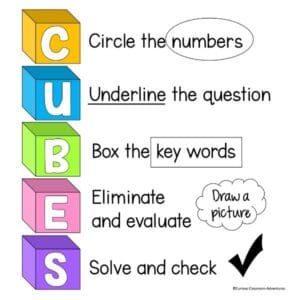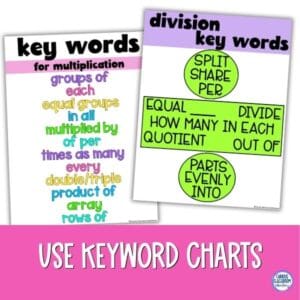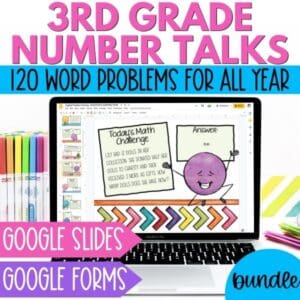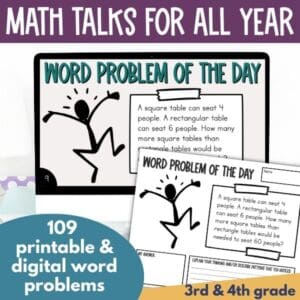It’s time to tackle the world of math word problems. You know, those tricky little puzzles that can make our students (and sometimes us) break into a sweat. Fear not! We’re arming ourselves with some top-notch problem solving strategies that will help our young mathematicians conquer these problems with confidence and maybe even a smile.
Meet C.U.B.E.S.: Your New Best Friend in Problem Solving
First up, let’s introduce our acronym: C.U.B.E.S. This strategy turns solving word problems into step-by-step pieces with a game plan. Here’s the breakdown:
- C: Circle the numbers. Get those kiddos to find and circle all the important numbers in the problem. It’s like a number scavenger hunt!
- U: Underline the question. What is the problem actually asking? Underline it so it stands out like a neon sign.
- B: Box the keywords. Look for those crucial words that hint at what operations to use. “Altogether,” “difference,” “product”—those words are gold!
- E: Eliminate and evaluate. Cross out the unnecessary info (you’d be surprised how much there is) and think about the best way to solve the problem. Plan of attack time!
- S: Solve and check. Work through the math and then double-check to make sure the answer makes sense. No one wants to be that person who forgot to carry the one!

Now that we’ve got C.U.B.E.S. down, let’s talk about some other nifty problem solving strategies to help our students shine.
Draw It Out
Visual learners, unite! Encourage students to draw pictures or diagrams to represent the problem. Whether it’s bar models, number lines, or simple sketches, seeing the problem can make a world of difference.
Break It Down
For those two-step word problems, breaking it down is key. Teach students to handle one step at a time. Solve the first part of the problem, then use that solution to tackle the next step. It’s like climbing a mountain—one step at a time gets you to the top! Students might find it helpful to highlight each step of the problem a different color to make them easier to analyze and decide which part of the problem needs to be solved first.
Think Aloud
Sometimes, the best way to understand a problem is to talk it out. Model this by thinking aloud as you solve a problem in front of the class. Show your thought process, including any mistakes and how you correct them. This makes learning new problem solving strategies feel less like magic and more like a skill they can learn. You can also hang anchor charts with keywords that signal each operation (addition, subtraction, multiplication, division) and refer to it often as you model as a reminder to students that they have resources around the classroom that can help them. Don’t forget to add new keywords to the chart as you find them!

Pair Up
Two heads are better than one! Pair students up and let them work on problems together. They can discuss their thought processes, correct each other’s mistakes, and celebrate their successes. Plus, it’s a great way to build those collaboration skills and problem solving strategies at the same time.
Practice, Practice, Practice
Finally, like anything in life, the more you practice, the better you get. Give students plenty of opportunities to solve word problems. A daily routine for problem solving strategies practice is perfect for this! Mix up the difficulty levels, and sprinkle in some real-life problems to keep things interesting. Maybe they can figure out how many cupcakes they need for a class party (always a winner!). These 3rd Grade Number Talks for All Year and Word Problems of the Day resources are some of my favorite tools for building a consistent routine for practicing problem solving strategies.
Keep It Fun and Encouraging
Remember, the goal is to make math fun and approachable. Using math games that involve logic are sure to boost the fun while students practice problem solving strategies.
Celebrate small victories and progress, no matter how minor they may seem. A little positive reinforcement goes a long way in building confidence and a love for problem solving.
There you have it! Armed with C.U.B.E.S. and a few other handy problem solving strategies, your students will be well on their way to becoming word problem pros.



